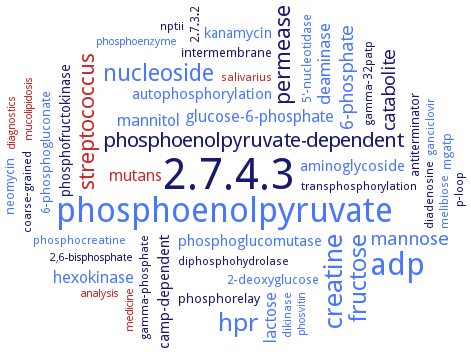2.7.4.3: adenylate kinase
This is an abbreviated version!
For detailed information about adenylate kinase, go to the full flat file.

Word Map on EC 2.7.4.3 
-
2.7.4.3
-
phosphoenolpyruvate
-
adp
-
creatine
-
hpr
-
fructose
-
nucleoside
-
permease
-
streptococcus
-
phosphoenolpyruvate-dependent
-
mannose
-
6-phosphate
-
catabolite
-
deaminase
-
lactose
-
mannitol
-
hexokinase
-
mutans
-
glucose-6-phosphate
-
camp-dependent
-
aminoglycoside
-
autophosphorylation
-
phosphoglucomutase
-
phosphofructokinase
-
kanamycin
-
neomycin
-
6-phosphogluconate
-
phosphorelay
-
5'-nucleotidase
-
antiterminator
-
mgatp
-
2-deoxyglucose
-
intermembrane
-
transphosphorylation
-
gamma-phosphate
-
melibiose
-
salivarius
-
ganciclovir
-
phosphocreatine
-
nptii
-
diadenosine
-
diphosphohydrolase
-
gamma-32patp
-
p-loop
-
2.7.3.2
-
dikinase
-
coarse-grained
-
analysis
-
phosvitin
-
medicine
-
2,6-bisphosphate
-
mucolipidosis
-
phosphoenzyme
-
diagnostics
- 2.7.4.3
- phosphoenolpyruvate
- adp
- creatine
- hpr
- fructose
- nucleoside
-
permease
- streptococcus
-
phosphoenolpyruvate-dependent
- mannose
- 6-phosphate
-
catabolite
- deaminase
- lactose
- mannitol
- hexokinase
- mutans
- glucose-6-phosphate
-
camp-dependent
- aminoglycoside
- autophosphorylation
- phosphoglucomutase
-
phosphofructokinase
- kanamycin
- neomycin
- 6-phosphogluconate
-
phosphorelay
- 5'-nucleotidase
-
antiterminator
- mgatp
- 2-deoxyglucose
-
intermembrane
-
transphosphorylation
-
gamma-phosphate
- melibiose
- salivarius
- ganciclovir
- phosphocreatine
- nptii
-
diadenosine
-
diphosphohydrolase
-
gamma-32patp
-
p-loop
-
2.7.3.2
- dikinase
-
coarse-grained
- analysis
- phosvitin
- medicine
-
2,6-bisphosphate
- mucolipidosis
- phosphoenzyme
- diagnostics
Reaction
Synonyms
5'-AMP-kinase, ABC adenylate kinase, AD-004 like protein, adenosine 5'-triphosphate:adenosine 5'-monophosphate phosphotransferase, adenylate kinase, adenylate kinase 1, adenylate kinase 2, adenylate kinase 4, adenylate kinase 5, adenylate kinase 6, adenylate kinase 9, adenylate kinase isoenzyme 1, adenylate kinase isozyme 2, adenylate kinase-2, adenylate kinase-like protein 1, adenylic kinase, adenylokinase, ADK, ADK1, ADK2, ADLP, AK1, AK2, AK4, AK5, AK5p1, AK5p2, AK6, AK7, AK8, AK9, AKE, AKlse4, AKm, AKmeso, AKp, AKpsycrho, AKthermo, ATP:AMP phosphotransferase, CFTR, CINAP, coilin interacting nuclear ATPase protein, cystic fibrosis transmembrane conductance regulator, DAK2, Dak6, kinase, adenylate (phosphorylating), kinase, myo- (phosphorylating), MeADK1, MeADK2, MJ0458, myokinase, nonstructural protein 4B, NS4B, pfSMCnbd, phosphotransferase, Rv0733, Saci_0573, SpAdK, structural maintenance of chromosome protein


 results (
results ( results (
results ( top
top





